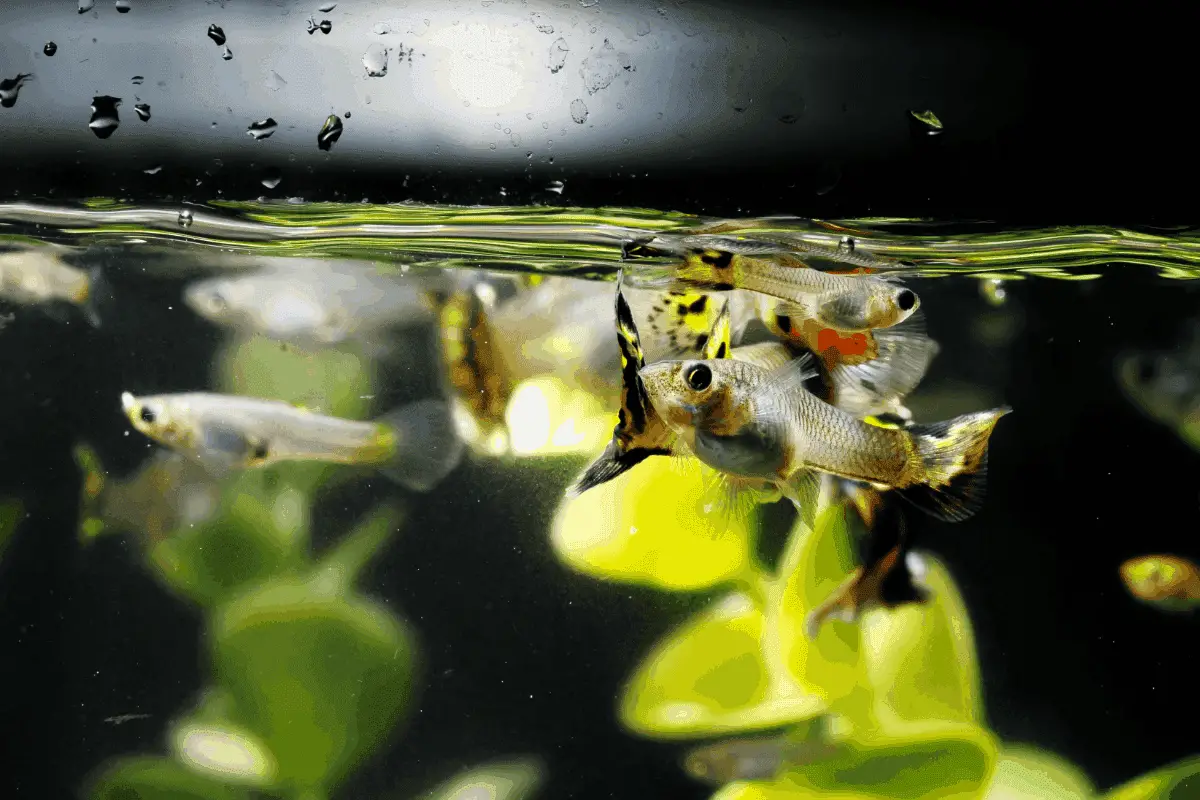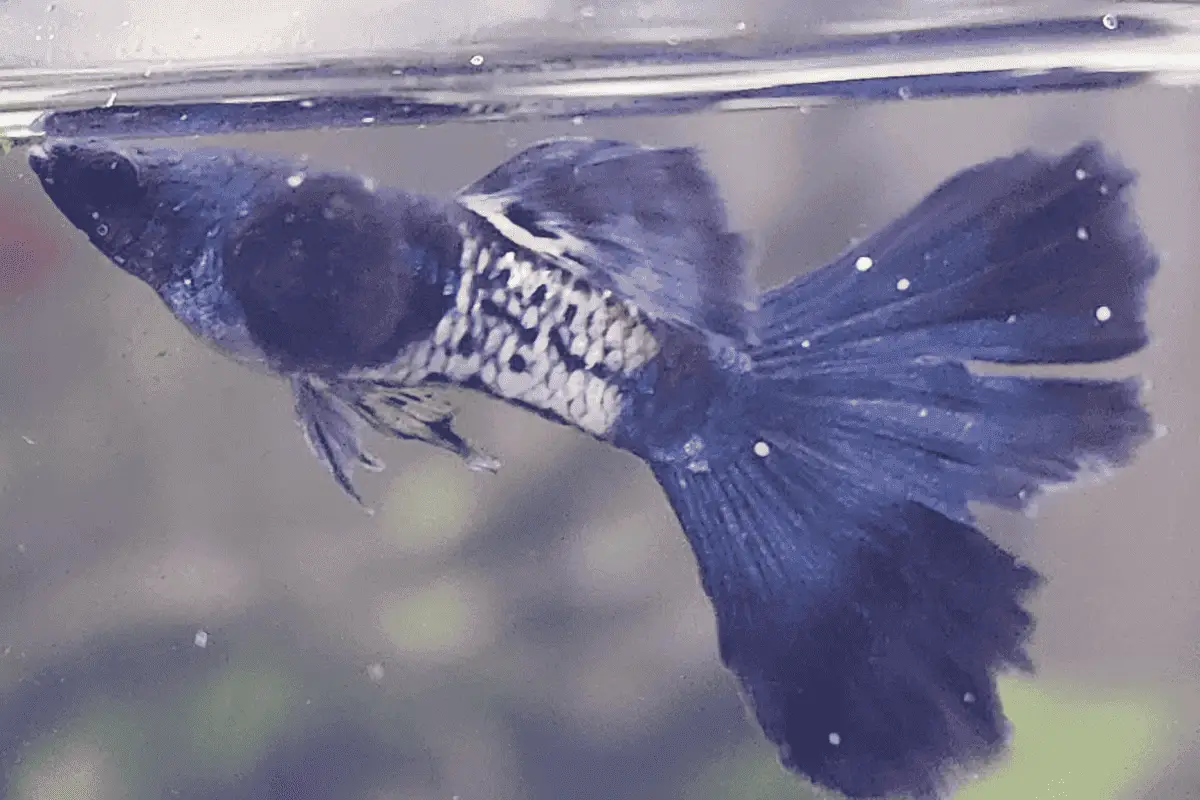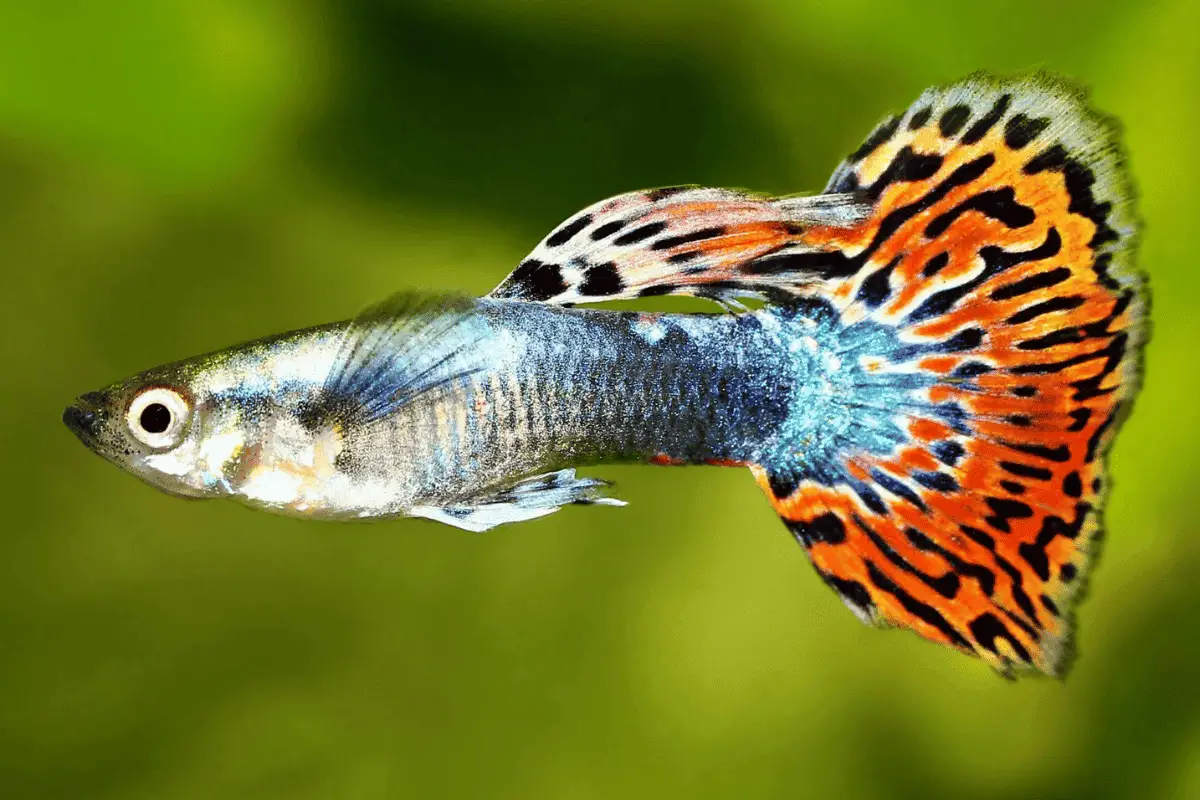Guppy fish are a favored pick for home aquariums due to their lively colors and ease of maintenance.
Yet, like other fish, guppies can face stress, and figuring out why isn’t always straightforward. That’s what inspired me to create this guide.
Through my time caring for guppy fish, I’ve noticed they’re quite responsive to environmental shifts. Sharing what I’ve learned seemed like a great idea.
In this article, I’ll walk you through 15 typical signs of stress in your guppy and provide useful remedies for each.
So, let’s dive right in.

My Equipment
Before we begin, here’s a list of things I use in my guppy fish tank to keep it comfy and stress-free:
| Equipment Product | Purpose |
| API FRESHWATER MASTER TEST (link to Amazon) | To check the quality of water in freshwater aquariums. |
| Hygger Aquarium Air Stone (link to Amazon) | To boost oxygen levels and generate bubbles in the aquarium. |
| Tetra AquaSafe (link to Amazon) | To ensure tap water is safe for fish by removing chlorine and heavy metals. |
| Fluval E300 Advanced Electronic Heater (link to Amazon) | To maintain consistent water temperatures in the aquarium. |
| Laifoo 7ft Aquarium Siphon (link to Amazon) | For conducting water changes and cleaning the gravel in the aquarium. |
| Seachem Nourish (link to Amazon) | Supplement with vitamins and minerals for plant health. |
| Seachem PolyGuard (link to Amazon) | A remedy for various fungal and bacterial infections in fish. |
| Jabukosu Aquarium Cave (link to Amazon) | To provide hiding and breeding places for fish |
| TetraCichlid Cichlid Flakes (link to Amazon) | Specialized food designed for cichlids and other fish to meet their nutritional needs. |
| Dr. Moss Malaysian Driftwood (link to Amazon) | To improve and enrich the natural environment within the aquarium. |
Also Read: Guppy Care Guide
15 Stress Signs in Guppy Fish
Here are the common indicators of stress in guppies:
1. Color Changes
Guppies often experience color changes when stressed, which can manifest as fading or dulling of their normally vibrant colors.
This is a reaction to various stressors such as poor water quality, inadequate diet, or illness. The change in color serves as an indicator that the fish is not in optimal health.
How to Treat:
- Adjust Water Conditions: Regularly test and maintain water parameters (pH 7.0-7.2, temperature 72-82°F), performing 25% water changes weekly.
- Improve Diet: Provide a balanced diet including high-quality flake food, frozen or live brine shrimp, and occasional vegetable supplements.
- Reduce Overcrowding: Ensure adequate space (at least 1 gallon per guppy) to prevent stress from overcrowding.
- Add Aquatic Plants: Introduce live plants to create a natural and comforting environment, aiding in stress reduction.
Also Read: Why Do Guppies Lose Their Color?
2. Staying at the Top

Guppies that are stressed often stay near the water surface.
This behavior can indicate poor water quality, particularly low oxygen levels, or can be a response to high ammonia or nitrite levels.
Staying at the top allows them easier access to oxygen but is a sign they are not comfortable in their environment.
How to Treat:
- Increase Aeration: Install an air stone or a stronger filter to enhance oxygenation of the water.
- Check Water Quality: Test for ammonia, nitrite, and nitrate levels, aiming for ammonia and nitrite at 0 ppm, and nitrate below 20 ppm.
- Adjust Temperature: Keep water temperature stable within the ideal range of 72-82°F to promote adequate oxygen levels.
- Provide Hiding Places: Add more plants or decorations to offer hiding spots and reduce stress.
Also Read: Guppies Staying At The Top
3. Aggressive Behavior
Aggressive behavior in guppies, such as chasing or nipping at other fish, is often a sign of stress.
This can be caused by overcrowding, competition for food, or lack of hiding spaces in the aquarium. Such behavior can lead to injury or stress in other fish as well.
How to Treat:
- Reorganize the Tank: Rearrange the aquarium layout to disrupt established territories and reduce aggression.
- Increase Feeding Frequency: Feed small amounts multiple times a day to reduce competition and aggression over food.
- Introduce More Hiding Spots: Add plants or decorations to provide more hiding and resting areas for all fish.
- Monitor Fish Compatibility: Ensure compatible species are housed together and remove overly aggressive individuals if necessary.
Also Read: Why Is My Guppy Bullying Other Fish?
4. Turning Black

When guppies turn black, it is often a sign of severe stress or an indication of a health problem such as a fungal or bacterial infection.
This color change can also be a response to environmental stressors like poor water quality or sudden changes in water parameters.
Immediate attention is required as this is a critical sign.
How to Treat:
- Check for Infections: Look for other signs of illness and consider treating with an appropriate aquarium-safe medication if needed.
- Stabilize Water Parameters: Make sure the water quality is optimal, with ammonia and nitrite at 0 ppm and stable pH levels.
- Reduce Stressors: Identify and eliminate any potential stressors, such as aggressive tank mates or rapid temperature fluctuations.
- Provide a Stress-Free Environment: Create a calm environment with minimal disturbances and a consistent light-dark cycle.
Also Read: Why Is My Guppy Turning Black?
5. Turning White
Turning white in guppies is often a sign of fungal or parasitic infections, which can be stress-induced.
It could also be a response to sudden changes in water temperature or poor water quality.
The whitening of their skin indicates a compromised immune system and requires immediate care.
How to Treat:
- Diagnose and Treat Infections: Identify the cause (fungal or parasitic) and treat with appropriate medication, following dosage instructions.
- Maintain Water Quality: Regularly check and maintain water parameters, including pH, ammonia, and nitrate levels.
- Stabilize Water Temperature: Ensure the water temperature is consistent, within the ideal range of 72-82°F.
- Enhance Diet: Boost their immune system with a varied diet rich in vitamins and nutrients, including vitamin supplements if necessary.
Also Read: Why Is My Guppy Turning White?
6. Twitching

Twitching in guppies can indicate stress or irritation, often caused by water conditions or parasites.
This manifests as sudden, spasmodic movements, signaling discomfort or distress.
How to Treat:
- Regular Water Tests: Check water parameters bi-weekly; aim for ammonia and nitrite at 0 ppm, nitrates below 20 ppm.
- Parasite Treatment: If parasites are suspected, use an anti-parasitic treatment like copper sulfate, following a dosage of 2 mg/L.
- Minimize Stress: Reduce tank traffic and noise, and provide natural day/night lighting cycles to create a calming environment.
- Observation: Monitor your guppy for other symptoms of illness and act swiftly if new symptoms appear.
Also Read: Why Is My Guppy Shaking?
7. Blowing Bubbles
Blowing bubbles can indicate respiratory distress or exposure to harmful substances.
This rare behavior in guppies suggests a serious underlying issue, often related to water quality or illness.
How to Treat:
- Toxin Assessment: Test for chlorine and heavy metals, using a water conditioner like Seachem Prime to neutralize toxins.
- Enhance Aeration: Add an air stone or increase filter flow to boost oxygen levels, aiming for a steady but gentle current.
- Antibiotic Use: If bacterial infections are suspected, use a broad-spectrum antibiotic, dosing as per the product’s instructions.
- Regular Water Changes: Conduct 30% water changes weekly, using a gravel vacuum to remove waste from the substrate.
Also Read: Why Do Guppies Blow Bubbles?
8. Drooping Tail

A drooping tail in guppies indicates physical stress or illness. It can be a sign of genetic issues, poor water conditions, or malnutrition, characterized by a limp tail posture.
How to Treat:
- Nutritional Improvement: Feed high-quality flake food and frozen daphnia; alternate daily for a balanced diet.
- Water Parameter Stability: Keep the water temperature at 78°F with a pH between 7.0-7.2, using a reliable aquarium heater and pH buffer.
- Veterinary Consultation: If symptoms persist, consult a vet for potential internal issues, especially for chronic cases.
- Stress Reduction: Provide ample hiding places like live plants or caves, maintaining a peaceful tank environment.
Also Read: Guppy Tail Drooping
9. Staying on the Bottom
Guppies staying at the bottom often indicates illness, stress, or poor water quality. This behavior shows they are avoiding swimming due to discomfort or weakness.
How to Treat:
- Water Quality Check: Test for ammonia, nitrites, and nitrates; use water conditioners to maintain ideal levels (0 ppm for ammonia and nitrites).
- Illness Identification: Observe for other illness signs (like fin rot) and treat with specific medications like antibacterial or antifungal, following the product guidelines.
- Tank Environment Optimization: Ensure the tank has varied topography with plants and shelters, avoiding overcrowded conditions.
- Dietary Assessment: Offer a varied diet including live foods like brine shrimp, ensuring they are getting adequate nutrition.
Also Read: Guppy Laying At The Bottom
10. Loss of Appetite

Loss of appetite in guppies is a significant stress indicator, often due to illness, environmental stressors, or incompatible tank mates.
How to Treat:
- Isolation for Observation: If possible, isolate the affected guppy in a quarantine tank to monitor food intake and behavior closely.
- Varied Diet: Introduce a variety of foods like micro worms and finely chopped vegetables to stimulate appetite, offering small portions twice daily.
- Stressor Identification: Examine the tank for aggressive fish, inappropriate water temperature (ideal range: 72-82°F), and fluctuating pH levels.
- Medical Treatment: If symptoms persist, consider a broad-spectrum treatment like Maracyn Two, following dosing instructions on the label.
11. Rapid Breathing
Rapid breathing in guppies often signals respiratory distress, which can be caused by poor water quality, lack of oxygen, or disease.
This is seen as quick gill movements and is a sign of discomfort.
How to Treat:
- Improve Oxygenation: Install an air pump or increase the flow rate of your filter to enhance oxygen levels in the water.
- Water Quality Management: Regularly test and adjust water parameters, especially maintaining ammonia and nitrite at 0 ppm.
- Check for Disease: Look for symptoms of gill diseases like white spots on gills and treat with an appropriate medication, dosing as per instructions.
- Stress Reduction: Create a peaceful environment with stable temperature (72-82°F) and consistent light-dark cycles.
Also Read: Guppies Diseases
12. Clamped Fins

Clamped fins, where a guppy keeps its fins close to the body, indicate discomfort, possibly due to poor water conditions, stress, or illness.
This behavior is a defensive posture and a sign of unhappiness.
How to Treat:
- Water Quality Check: Test for ammonia, nitrites, and nitrates, aiming for ammonia and nitrite levels at 0 ppm and nitrates under 20 ppm.
- Stress Minimization: Reduce tank traffic and noise, and provide a stable environment with natural day/night light cycles.
- Disease Inspection: Examine for signs of infections like fin rot and treat with specific medications, adhering to dosage recommendations.
- Environmental Enrichment: Add live plants and hiding places to the tank to provide a sense of security and comfort.
13. Rubbing Against Objects
Rubbing against objects, also known as “flashing,” typically indicates skin irritation or parasites.
It can be caused by poor water conditions or an infestation of parasites like ich or flukes.
How to Treat:
- Parasite Treatment: Use anti-parasitic medication like malachite green, dosing 0.05 mg/L of water, for suspected parasite infestations.
- Water Quality Improvement: Keep the tank clean with regular 25-30% water changes and maintain a stable water temperature of 78°F.
- Monitor for Infections: Look for other symptoms of skin infections and treat with appropriate medications if necessary.
- Reduce Stress Factors: Provide a peaceful tank environment with plenty of hiding places and minimal disturbance.
14. Hiding More Than Usual

Excessive hiding in guppies can be a sign of stress or fear, often caused by aggressive tank mates, poor water conditions, or lack of hiding spots.
How to Treat:
- Tank Mate Assessment: Remove or rehome aggressive fish and ensure a harmonious community in the tank.
- Water Parameter Stability: Regularly check and maintain water conditions, keeping ammonia and nitrite levels at 0 ppm.
- Provide Hiding Places: Introduce more plants and decorations to offer safe hiding spots and reduce stress.
- Monitor Feeding: Ensure the shy guppy is eating; consider feeding in different areas of the tank to avoid competition.
15. Erratic Swimming
Erratic swimming, such as darting or swimming in an unusual pattern, often indicates stress or a health issue.
This can be due to water quality problems, disease, or environmental stressors.
How to Treat:
- Water Quality Maintenance: Conduct regular water tests; keep ammonia and nitrite at 0 ppm and nitrate levels low.
- Disease Diagnosis: Look for signs of neurological or swim bladder disorders and consult a vet for potential treatment options.
- Environmental Stability: Ensure the tank environment is stable with consistent temperature and pH levels.
- Minimize Stress: Provide a calm environment, avoiding sudden changes in lighting or loud noises near the tank.
What Causes Stress in Guppies?
Stress in guppies is commonly triggered by environmental factors and poor tank conditions.
These triggers can lead to behavioral changes and health issues, significantly affecting their well-being.
- Poor Water Quality: Ammonia levels above 0 ppm or drastic pH shifts can cause stress. Regular testing and maintaining a pH between 7.0-7.2 are crucial for their health.
- Overcrowding: Too many fish in a small space lead to stress; ideally, keep one guppy per gallon to ensure enough swimming room and reduce aggression.
- Inadequate Diet: A monotonous or nutritionally poor diet can weaken their immune system. Feed a varied diet including flakes, live brine shrimp, and vegetable supplements.
- Aggressive Tank Mates: Housing guppies with aggressive or fin-nipping species can cause constant stress. Choose peaceful, similarly-sized fish to keep the community harmonious.
For example, here are some common aggressive species that shouldn’t be mixed with guppies:
- Tiger Barbs
- Oscars
- Jack Dempseys
- Red-tailed Sharks
- Green Terror Cichlids
- Arowanas
- Flowerhorns
- Convict Cichlids
- African Clawed Frogs
- Pacu

Stick to more peaceful species like:
- Neon Tetras
- Corydoras Catfish
- Platies
- Mollies
- Swordtails
- Cherry Shrimp
- Harlequin Rasboras
- Endler’s Livebearers
- Dwarf Gouramis
- Zebra Danios
Spotting Stress in Guppies vs. Their Normal Behavior
Identifying stress in guppies involves observing deviations from their typical behavior and physical appearance.
Normal guppy behavior includes active swimming and vibrant coloration, while stress signs are markedly different.
- Color Changes: Normally vibrant and colorful, stressed guppies often exhibit faded or dull colors. Sudden color loss is a clear indication of stress or illness.
- Hiding Behavior: While guppies occasionally explore tank decorations, excessive hiding, especially during feeding times, suggests stress or fear.
- Erratic Swimming: Guppies typically swim smoothly; erratic or darting movements are stress indicators, possibly due to poor water conditions or illness.
- Loss of Appetite: Guppies are generally eager eaters. A noticeable decrease in appetite or ignoring food can be a sign of stress or health issues.

Consequences of Ignoring Stress in Guppy Fish
Ignoring stress in guppy fish can lead to severe health problems, including a weakened immune system, making them more susceptible to diseases.
Chronic stress can also result in behavioral changes such as decreased social interaction and breeding issues.
In extreme cases, prolonged stress can be fatal, as it significantly impairs their physiological functions and overall well-being.
Also Read: Why Are My Guppies Dying?
Can a Stressed Guppy Fish Fully Recover?
Yes, a stressed guppy fish can fully recover if the source of stress is identified and eliminated promptly.
Recovery involves improving water quality, ensuring a balanced diet, and providing a peaceful environment.
However, the success of recovery greatly depends on how quickly the stress is addressed and the overall health of the fish prior to the onset of stress.
Also Read: 21 Facts About Guppies

Conclusions
For quick readers, here’s a short summary:
- Stress in guppies manifests in various forms such as color changes, erratic swimming, and loss of appetite, indicating issues like poor water quality, overcrowding, or disease.
- Effective solutions for stress in guppies include maintaining optimal water quality, providing a balanced diet, and creating a stress-free environment with adequate hiding spaces.
- Neglecting signs of stress in guppies can lead to severe health issues, weakened immunity, behavioral changes, and potentially fatal consequences.
- Identifying and promptly addressing stressors is crucial; a stressed guppy can fully recover with improved water conditions, proper diet, and a peaceful tank environment.
- Compatibility with tank mates is vital; guppies should be housed with peaceful species to prevent stress from aggressive interactions.

